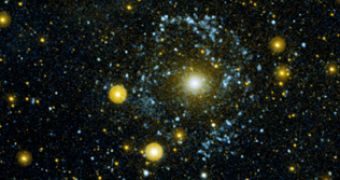NASA's Galaxy Evolution Explorer instrument is set for a mission to survey all the width of the sky in ultraviolet light for the first time. During its most recent surveys, it came upon a lenticular galaxy called NGC 404 that lies beyond a red giant star named Mirach, which obscures it from normal view with its glaring light. Due to the fact that it is normally hard to spot, scientists called the galaxy the “Ghost of Mirach.” Further analysis of the celestial “creature” indicated that the concepts about the formation and evolution of this type of galaxy were overdue.
The lenticular galaxies come in the shape of a disk, lacking spiral arms and a highly-active star formation process. According to Baltimore researcher David Thilker from Johns Hopkins University, “We thought this celestial ghost was essentially dead, but we've been able to show that it has an extended ring of new stars. The galaxy has a hybrid character in which the well-known, very old stellar population tells only part of the story. It's like the living dead.”
The Ghost of Mirach was also found to be enveloped in a ring of ultraviolet-bright stars, which was a first sight for the experts. Subsequent studies determined that the ring was comprised of hydrogen gas, formed as a result of a collision between NGC 404 and a former neighboring galaxy 900 million years back. The gas gave birth to relatively young stars, which now emit the ultraviolet light spotted by the Galaxy Evolution Explorer.
“Before the Galaxy Evolution Explorer image, NGC 404 was thought to contain only very old and evolved red stars distributed in a smooth elliptical shape, suggesting a galaxy well into its old age and no longer evolving significantly. Now we see it has come back to life, to grow once again,” explained Mark Seibert from the Observatories of the Carnegie Institution of Washington in Pasadena, California. Thilker agrees: “The Ghost of Mirach has been lucky enough to get a new lease on life through the rejuvenating, chance merger with its dwarf companion.”
The finding demonstrates that the evolution of lenticular galaxies is not complete, and that they keep spawning stars at slow rates by feeding off the star gas of their galaxy neighbors, making formations such as the Ghost of Mirach rather a vampire than a ghost galaxy.

 14 DAY TRIAL //
14 DAY TRIAL // 
